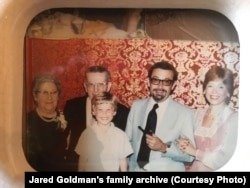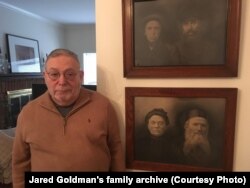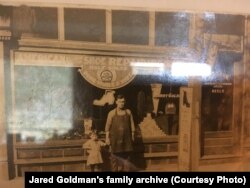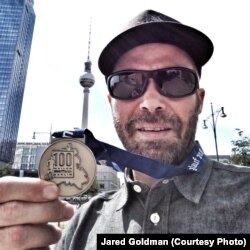Jared Goldman was born in the US and grew up in St. Louis Mo. He has been living in Berlin for the last 18 years. This summer he plans to travel to Belarus, to run 230 kilometers from Minsk to the Kažan-Haradok in the Luniniec district. His grandfather Hetzke emigrated to the US from this Paliessie town in the early 20th century.
From train kitchen worker to European traveller
In 1910, Hetzke Birenbeif, born in Jewish community in the Paliessie town of Kažan-Haradok, arrived in the United States. Joining him there three years later were his wife Schaindel (nee Aronson) and their son Maurice. In the New World, Hetzke and Shaindel became Harry and Jenny Goldman. It is unclear whether they chose their new names voluntarily or they were chosen for them.
The Goldmans settled in St. Louis, MO. All of their descendants come from there. In the last one hundred years, none has ever visited Belarus.
“They never really talked about Belarus,” says Jared today, recalling conversations between his father and grandfather.
Jared grew up in St. Louis. Opting against college, he embarked instead on a life of travel. After criss-crossing the US, he took a job on the American Orient Express.
This was, as Jared explains, “a five-star hotel on wheels for wealthy travelers to relive the nostalgia of train travel.”
For the next three years he worked in the train’s kitchen. He was earning money but had virtually no opportunity to spend it. Eventually, he went to work in Orient Express corporate office, where he was responsible for purchasing.
“I left the company because I was still young, and no longer felt challenged,” says Jared. “I decided to leave for Europe on a year long backpacking trip.”
Jared was 24 when he arrived in Berlin. The city impressed him, and he decided to stay. It was, as he says, at that time a city “off the beaten path.”
Stopped drinking and started running
At the outset, he found lodging in of only three hostels existing at the time. He made friends with the owner and eventually took a job there. The company grew and so did he. Jared ended up managing a part of the network, which included bars, restaurants, other hostels and hotels. He spent 17 years working with them in Berlin.
“As I got older, I decided I did not want to work around alcohol anymore. I had been living a pretty rock-and-roll lifestyle, and was not headed in a good direction,” he says now.
And so, Jared stopped drinking. But before he made that decision, he had discovered running. Every year he would watch the participants of the Berlin marathon. Inspired by the athletes, he embarked on his own first 10-kilometer race.
Over the past two years, he ran in two marathons in Germany, and several half-marathons in the United States, Vietnam and Cambodia. In 2017, he ran an “ultra-marathon” — a 60-kilometer race around the former Berlin wall.
Running has become a part of his life. Jared says he even runs while travelling.
“I love running no matter where I go. It’s a great way to see new places,” he explains.
“I want to learn about the place that I come from”
Last year Jared left his job with the intent of discovering what he would do next.
“I decided I wanted to do epic runs, to be challenged,” he said. “I’m still looking for the perfect career that includes my passion for running.”
This is how his idea to make a marathon run around Belarus came into fruition. He’s still developing a plan. In total, he wants to run 230 kilometers from Minsk to the Kažan-Haradok. He plans on running 25 to 30 kilometers each day. With breaks, the entire trip, he estimates, will take him around two weeks.
“I want to experience more about the place from which I came,” Jared says and, in the process, “hope to surmount some physical barriers which will help me to learn more about myself.”
He’s already begun training, running up to 70 kilometers each week. From the beginning of the year, he’s already clocked in five hundred kilometers.
Jared was dismayed about the challenges he might encounter during his run along Belarusian roads. Since roads have no real “shoulders,” he should avoid highways with intense traffic. Drivers are also unaccustomed to sharing roads with runners.
“I hope there’s less vehicular traffic on some of the smaller roads. I may start out very early in the morning to avoid traffic; it also might be a whole lot cooler at that time of the day,” says Jared.
Seeking Belarusians to join the race in Kažan-Haradok
As a child, Jared didn’t give much thought to his grandparents or where they came from. He grew up in an ordinary American family. This year, he will be the first among all his relatives to visit Belarus, a full century after their initial departure.
“As I grew older, and understood the world better and got curious about who I am, I started looking into my father’s side of the family,” explains Jared Goldman.
Jared is now looking for locals who might be interested in joining him for his Belarus marathon. If anyone’s interested in helping him organize the project, they can reach Jared via Instagram or Twitter.
Jared plans on spending a couple of days In Kažan-Haradok, where he’s like to learn more about the life of his ancestors there.
Jared’s also looking for contacts with charitable organizations that work with communities which suffered from the consequences of the Chernobyl nuclear disaster.
“I would like to link my run with an organization that can raise money for people or communities that need help and support,” he says.
His plan is to arrive in Belarus this August. There are a lot of moving parts to the project, he says. One of the first things he will do is send a letter to the Belarusian embassy in Berlin, “not to spring any surprises on the authorities.”
About Kažan-Haradok
K-H is a town with a long history in southern Belarus’s Palessie region, 230 km from Minsk. It was first mentioned in historical chronicles in the year 1493. According to a 1987 census, 3.9 thousand people live in K-H, 1.6 thousand of whom are Jews. At the time, K-H had but a single synagogue, and two other private places of worship for Jews.
Today Kažan-Haradok is the center of the village council. One thousand seven hundred people live here. Among the sights - a wooden Eastern Orthodox church dating back from the early 19th century.











